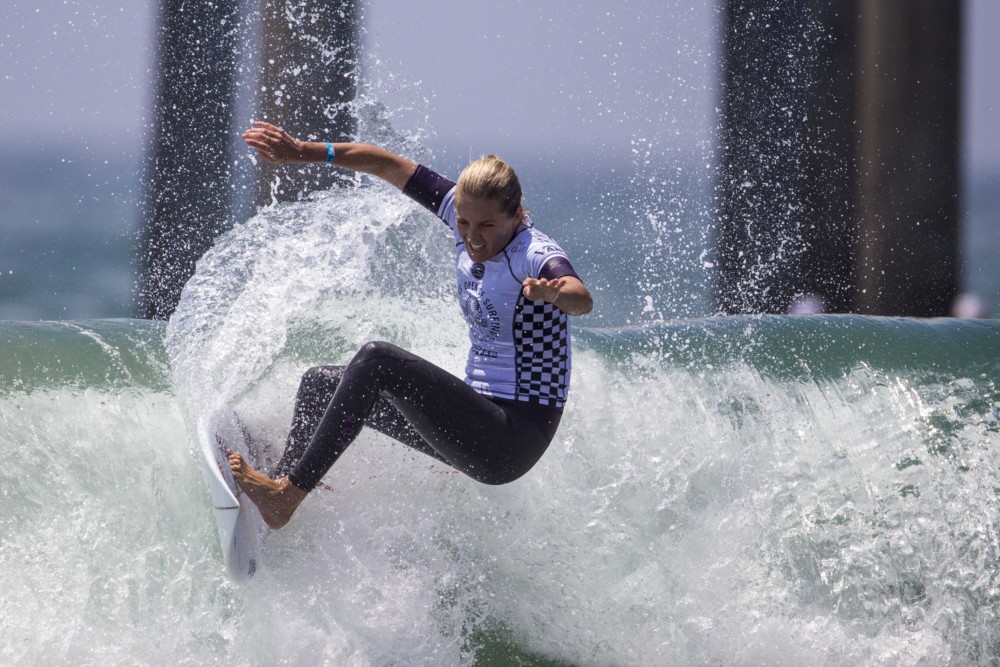By Laylan Connelly
The Orange County Register
WWR Article Summary (tl;dr) Currently, women take home $50,000 for a World Tour win, while men earn $100,000.
The Orange County Register
Since the start of professional surfing, women have earned a fraction of that earned by their male counterparts. They surf the same waves, in the same ocean. They are supported by the same surfwear brands that sponsor the athletes. But like other sports, the pay discrepancy was overly apparent between the two genders.
That will now change, at least for contests at the highest professional level, the World Surf League announced on Wednesday.
The equal prize money for WSL-controlled events will happen in the 2019 season and beyond, according to a news release sent as the world’s top surfers get ready to compete at Kelly Slater’s man-made wave pool in Lemoore, California starting Thursday, Sept. 6.
In 2009, Courtney Conlogue shows off her $10,000 check she received after winning the women’s final at the US Open of Surfing. Brett Simpson also won that year — earning a $100,000 check. (File photo by Drew A. Kelley, SCNG)
The news is touted as “the first and only US-based global sports league, and among the first internationally, to achieve prize money equality.”
“This is the latest in a series of actions the League has undertaken to showcase our female athletes, from competing on the same quality waves as the men, to better locations, and increased investment and support,” said WSL CEO Sophie Goldschmidt, in a release.
The change was simply the right thing to do, she stated.
“We want to be at the forefront of pushing for equality in all walks of life, starting on the waves, and we feel very lucky to have women on our tour who are highly talented, iconic role models, and more than deserve this recognition as they stand alongside our extraordinary male athletes.”
Towards equality
The WSL has made major strides in the past few years when it comes to gender equality, like hiring a woman — Goldschmidt — in 2017 to run the male-dominated league for the first time.
In recent years, there have been more stops added on the women’s pro tour, going from 14 seven years ago to 64 scheduled in 2019.
The prize money for women has slowly been making strides.
In 2009, for example, Santa Ana’s Courtney Conlogue earned a $10,000 check for her win at the U.S. Open of Surfing in Huntington Beach. The male surfer, Brett Simpson, earned $100,000 for the same event.
Currently, women take home $50,000 for a World Tour win, while men earn $100,000. In the past, the pay dispersal system was touted as fair because with fewer women competing on the tour than men, the entire purse was split equally among all the athletes.
In recent months, the World Surf League came under fire when a photo from a contest in Australia went viral, showing a male pro junior surfer clutching an $8,000 check beside a girl holding a check for half the amount.
The sport has also been under pressure recently to equalize prize money for the Mavericks Challenge near Santa Cruz, part of its Big Wave World Tour schedule. The California State Lands Commission earlier this month released a report that recommended granting a permit to the WSL to run the event only if prize money for the men’s and women’s events were equal.
A group called The Committee for Equity in Women’s Surfing lobbied the California Coastal Commission earlier this year to demand equal pay for women athletes before they granted any permits for the event, according to Surfer Magazine.
Whether those demands from the government had any impact on the change in pay structure is unclear.
Reactions
Conlogue on Wednesday said it was a day she dreamed of, and the female surfers who came before her made it possible.
“I don’t think we’d be here today if it wasn’t for them,” she said via cell phone from Lemoore. “It’s going to be amazing to reap the rewards of all the pioneers.”
She also thinks about the sport’s future athletes.
“We get to grow and keep evolving as a sport for that next generation. It’s a starting point,” Conlogue said.
Six-time world champion Stephanie Gilmore was “thrilled” about the changes.
“From the moment current ownership became involved, the situation for the women surfers has been transformed for the better in every way,” she said in a news release. “I hope this serves as a model for other sports, global organizations and society as a whole.”
But surfer Ryan Haeger said the sport took a giant step backward with the move. He also said the U.S. Open of Surfing would not exist if it was just the women surfing.
“They should have their own tour then and quit trying to ride the coattails of men,” he wrote on social media, calling it a joke and ridiculous.
Slater, an 11-time world champion surfer, said the women on tour deserved the equal pay.
“I’m so proud that surfing is choosing to lead sports in equality and fairness. The female WSL athletes are equally committed to their craft as the male athletes and should be paid the same,” Slater said in the announcement.
The equal pay covers the men’s and women’s championship tour, the Longboard Tour, the World Junior tour and the Big Wave Tour. At lower level Qualifying Series events, where sponsors control the prize money, the WSL will work with partners to “achieve equality as soon as possible.”
In addition to the prize money, other commitments were highlighted to shine a light on women’s surfing, including a global marketing campaign to help increase event viewership and fan engagement, surfing clinics by some of the best female surfers at contest stops, and a monthly series about the pioneers of women’s surfing, starting next week with seven-time World Champion Layne Beachley.














































































































































































































































































































































































